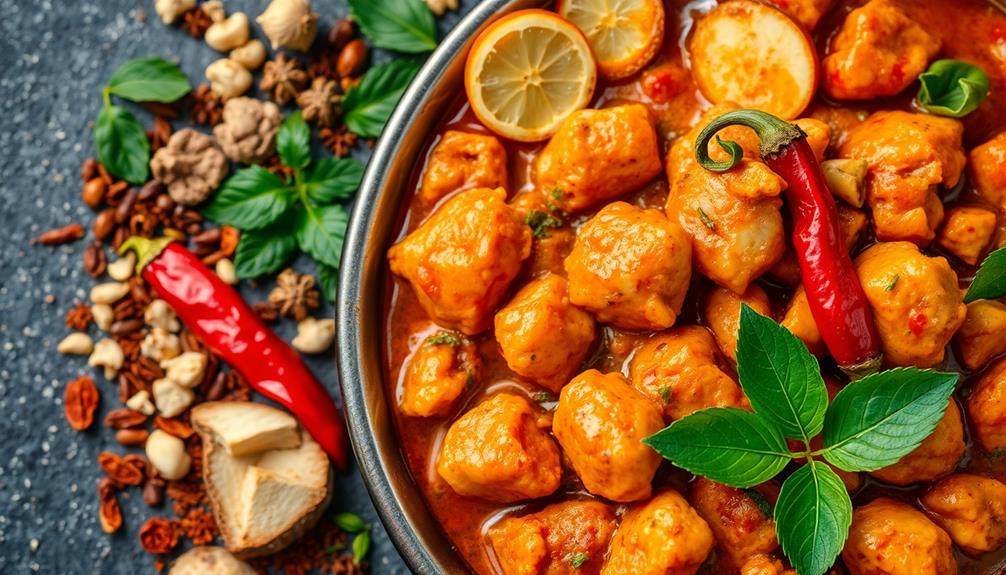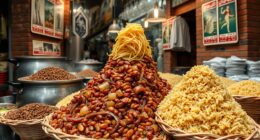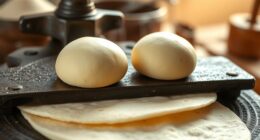Naan is a soft, fluffy flatbread that's popular in Indian cuisine and loved around the world. You'll find it's perfect for scooping up curries or wrapping around grilled meats. This tasty bread has a rich history, dating back to ancient Persia. To make naan, you'll mix flour, yeast, and yogurt, then let the dough rise overnight. When you're ready to cook, shape the dough into ovals and bake them in a hot tandoor oven or on a griddle. Don't forget to brush your freshly cooked naan with melted butter or ghee for extra flavor! There's so much more to discover about this delightful bread.
Key Takeaways
- Naan is a traditional Indian flatbread known for its soft, pillowy texture and golden-brown exterior.
- It originated in ancient Persia and gained popularity through trade routes across Asia.
- Key ingredients include flour, yeast, yogurt, and ghee, with optional additions like garlic or herbs.
- Traditionally cooked in a tandoor oven, naan can also be made on a stovetop or in a regular oven.
- Naan is versatile, pairing well with various dishes or enjoyed as a standalone snack.
History
The origins of naan stretch back thousands of years. You'll find this delicious flatbread has a long and fascinating history that's as rich as its flavor. Naan's story begins in ancient Persia, where it was first baked in hot tandoor ovens. As trade routes expanded, so did naan's popularity. It traveled across Asia, becoming a staple in many cultures.
You might be surprised to learn that naan wasn't always the fluffy bread you know today. Early versions were much flatter and denser. Over time, bakers discovered that adding yeast or baking powder made the dough rise, creating the soft, pillowy texture we love.
In India, naan became a favorite at the royal courts of the Mughal emperors. It was considered a luxury food, often served with rich curries and kebabs.
As you explore naan's history, you'll see how it's evolved from a royal treat to a beloved everyday bread. Today, you can find naan in restaurants and homes around the world, each region adding its own unique twist to this ancient recipe.
Recipe
Naan is a beloved Indian flatbread that has gained popularity worldwide for its soft, pillowy texture and delicious flavor. Traditionally baked in a tandoor oven, this versatile bread can also be made at home using a regular oven or stovetop method. The key to achieving the perfect naan lies in the dough preparation and cooking technique.
This recipe provides a simple yet authentic method for making naan at home. While it may not replicate the exact taste of tandoor-baked naan, it comes remarkably close and allows you to enjoy freshly made naan anytime. The dough is enriched with yogurt, which adds tenderness and a slight tang to the bread, while the addition of ghee or butter gives it a rich flavor and helps achieve those characteristic brown spots.
- 3 cups all-purpose flour
- 1 tsp active dry yeast
- 1 tsp sugar
- 1 tsp salt
- 1/4 cup plain yogurt
- 2 tbsp ghee or melted butter
- 3/4 cup warm water
- 1 tbsp nigella seeds (optional)
- Extra ghee or butter for brushing
To make naan, start by activating the yeast in warm water with sugar. In a large bowl, mix the flour and salt, then add the activated yeast mixture, yogurt, and ghee. Knead the dough until smooth and elastic, about 8-10 minutes. Cover and let it rise in a warm place for 1-2 hours.
Divide the dough into 8 portions and roll each into an oval shape. Sprinkle with nigella seeds if desired. Preheat a heavy skillet or griddle over high heat. Cook each naan for 1-2 minutes on each side until puffy and spotted with brown bubbles. Brush with melted ghee or butter immediately after cooking.
For best results, ensure your cooking surface is very hot before adding the naan. If using an oven, preheat it to its highest setting with a baking stone or inverted baking sheet inside. Slap the naan onto the hot surface and cook for 1-2 minutes until bubbled and browned.
You can also try adding flavors like minced garlic or chopped herbs to the dough for variety. Serve the naan warm, and if not eating immediately, wrap in a clean kitchen towel to keep soft.
Cooking Steps
Let's explore the exciting process of making naan!
You'll start by mixing flour and yeast, then knead the dough until it's smooth and let it rise overnight for the best flavor.
Once your dough is ready, you'll shape it into rounds and cook them in a traditional tandoor oven, giving your naan that authentic taste and texture.
Step 1. Mix Flour and Yeast

To begin crafting your naan dough, you'll need to combine the flour and yeast. First, grab a large mixing bowl and pour in about 3 cups of all-purpose flour. Make a small well in the center of the flour, and that's where you'll add your yeast. For this recipe, you'll want to use active dry yeast, about 1 teaspoon.
Now, it's time to wake up those tiny yeast organisms! Add a tablespoon of sugar to the well; this will give the yeast something to munch on. Next, pour in half a cup of warm water. The water should feel comfortably warm to your touch, not hot.
Gently stir the yeast mixture and let it sit for about 5 minutes. You'll know it's ready when you see little bubbles forming on top.
Once your yeast is bubbly, it's time to mix everything together. Use your hands or a wooden spoon to combine the flour with the yeast mixture. Don't worry if it looks a bit messy at first; that's perfectly normal!
Keep mixing until all the flour is incorporated and you've got a shaggy dough.
Step 2. Knead Dough Until Smooth
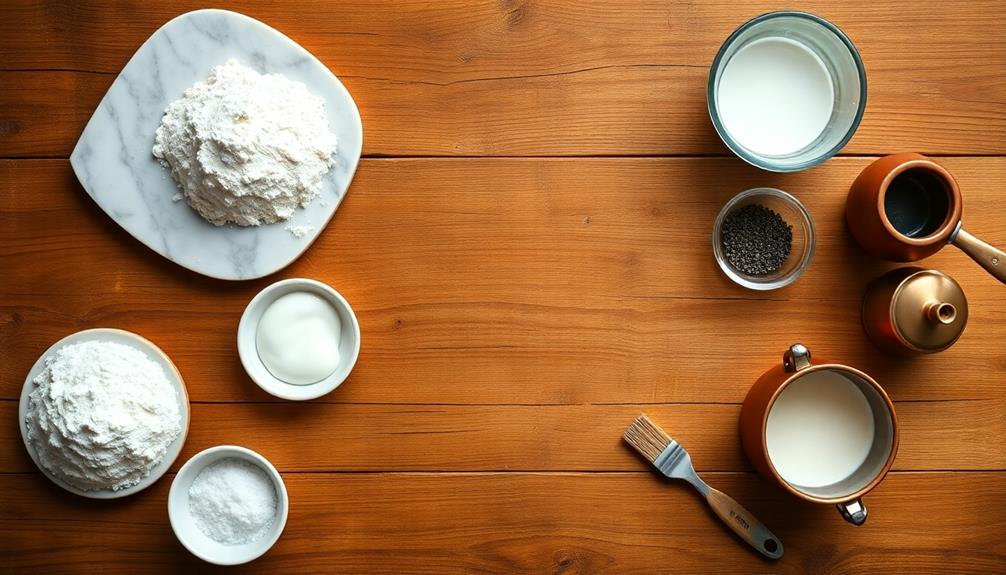
Kneading transforms your shaggy dough into a smooth, elastic ball. It's time to get your hands dirty! Flour your work surface lightly and turn out the dough. Use the heel of your hand to push the dough away from you, then fold it back over itself. Give it a quarter turn and repeat. You'll feel the dough changing as you work it.
Keep kneading for about 8-10 minutes. It's a bit of a workout, but it's worth it! As you knead, the gluten in the flour develops, giving your naan its signature chewy texture.
You'll know you're done when the dough feels smooth and springy. If you poke it gently, it should bounce back.
If the dough gets sticky, don't worry. Just dust your hands with a little more flour. Remember, practice makes perfect. The more you make naan, the better you'll get at knowing when the dough is just right.
Once it's smooth, form it into a ball. You're now ready for the next step in your naan-making adventure!
Step 3. Let Dough Rise Overnight
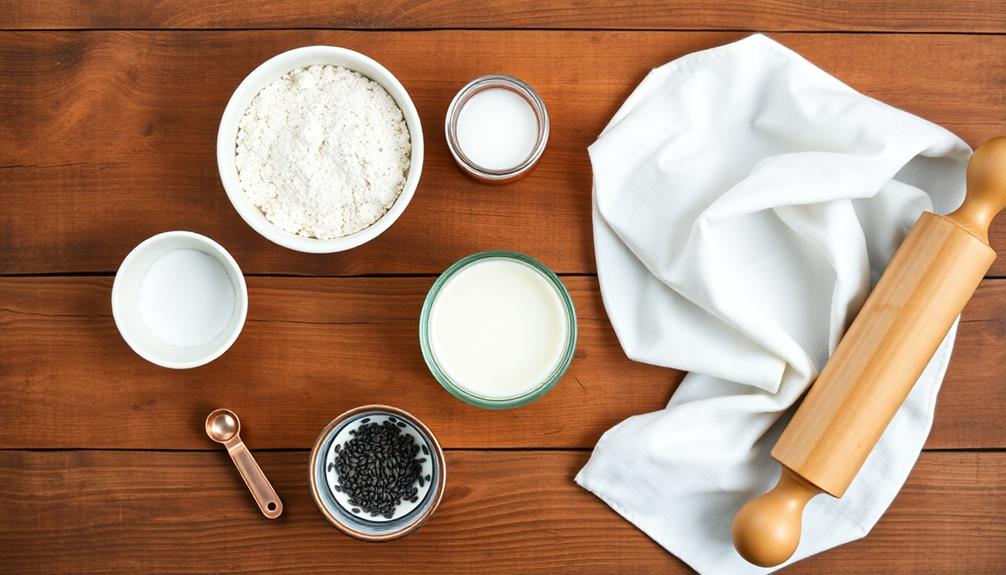
After kneading, your dough is ready for its beauty sleep. Now it's time to let it rest and grow overnight. Grab a large, clean bowl and lightly oil it to prevent sticking. Place your dough ball in the bowl and cover it with a damp cloth or plastic wrap. This will keep the dough moist and allow it to rise properly.
Find a warm, draft-free spot in your kitchen for the dough to rest. The ideal temperature is around 70-75°F (21-24°C). You'll want to let it sit for at least 8 hours, but overnight is best.
During this time, the yeast will work its magic, causing the dough to double in size and develop those delicious flavors we love in naan.
In the morning, you'll wake up to a puffy, risen dough that's full of tiny air bubbles. These bubbles will help create that light, fluffy texture we're aiming for.
Don't worry if it's risen a lot – that's exactly what we want! Your patience will be rewarded with perfectly textured naan bread.
Step 4. Shape Dough Into Rounds
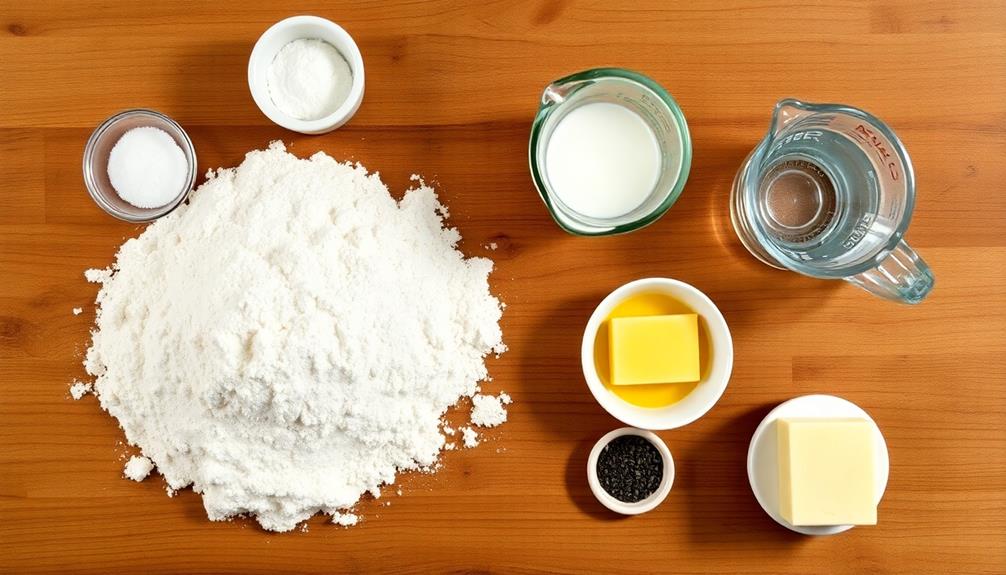
The next step in your naan-making journey involves shaping the dough into rounds. After your dough has risen overnight, it's time to get your hands a little messy! Gently punch down the dough to release the air, then turn it out onto a lightly floured surface.
You'll want to divide the dough into 8 to 10 equal portions, depending on how big you'd like your naan to be.
Now, here's where the fun begins! Take each portion and roll it into a ball using your palms. Don't worry if they're not perfect – that's part of the charm of homemade naan.
Once you've got your dough balls, it's time to flatten them. Use a rolling pin to roll each ball into an oval shape, about 1/4 inch thick. If the dough sticks, just sprinkle a bit more flour on your surface.
Remember, the irregular shape adds character to your naan, so don't stress about making them perfectly round. As you shape each piece, set it aside on a lightly floured tray or board.
You're now ready for the next exciting step in creating your delicious naan!
Step 5. Cook in Tandoor Oven
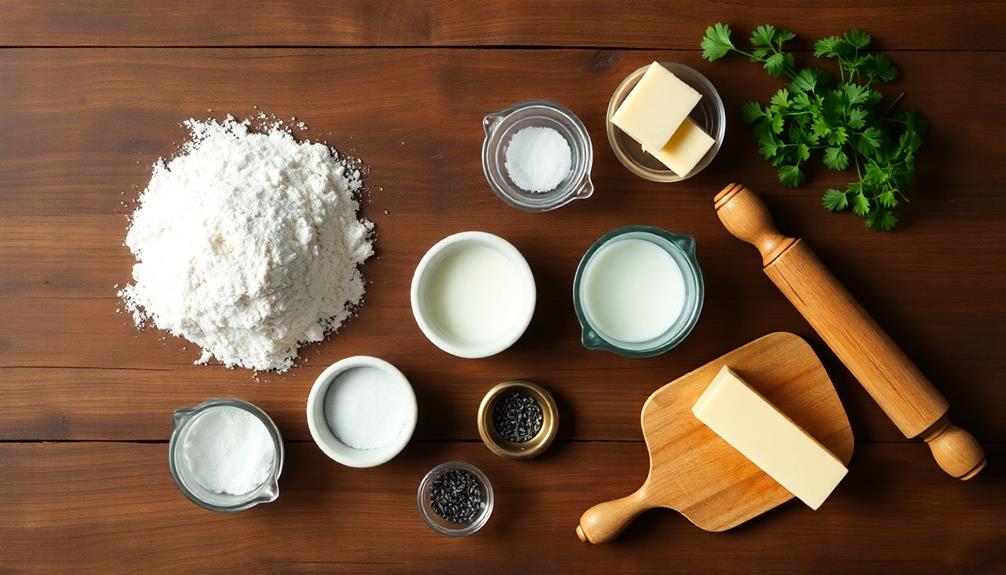
Now that you've shaped your naan rounds, it's time to fire up the tandoor oven. This special clay oven gets incredibly hot, creating the perfect environment for baking naan. After carefully placing the naan rounds inside the tandoor oven, you can start preparing the traditional recipe for rogan josh. This aromatic and flavorful curry dish typically includes tender pieces of meat cooked in a rich, spicy sauce. Using authentic spices and cooking techniques, you can create a rogan josh that perfectly complements the freshly baked naan. The combination of these two traditional dishes will surely transport you to the vibrant streets of India.
If you don't have a tandoor, don't worry! You can use a regular oven with a pizza stone or a cast-iron skillet on the stovetop.
Once your tandoor is hot, carefully slap the naan dough onto the inside walls. The dough will stick to the surface, and you'll see it start to bubble and puff up.
Keep an eye on your naan as it cooks quickly, usually in just 1-2 minutes. The intense heat will give your bread those signature charred spots and a crispy exterior while keeping the inside soft and fluffy.
When the naan is golden brown with dark spots, it's ready to come out. Use long-handled tongs to remove the bread from the oven walls. Be careful, as the tandoor is extremely hot!
Place your freshly baked naan on a plate and brush it with melted butter or ghee for extra flavor. Your homemade naan is now ready to enjoy with your favorite curry or as a delicious snack on its own.
Final Thoughts
Exploring the world of naan reveals a bread that's both simple and complex. As you've learned, this versatile flatbread has a rich history and countless variations. You can enjoy naan in many ways, from a humble accompaniment to curries to a standalone snack.
It's amazing how a few basic ingredients can transform into such a delicious and satisfying bread.
Remember, while traditional naan is cooked in a tandoor oven, you can still make delicious versions at home using your regular oven or stovetop. Don't be afraid to experiment with different toppings and flavors to find your favorite combination.
Whether you prefer it plain, garlic-infused, or stuffed with savory fillings, there's a naan for every taste.
Next time you're at an Indian restaurant or trying your hand at home cooking, give naan a try. You'll discover why it's beloved across many cultures.
Its soft, pillowy texture and slightly charred exterior make it the perfect vehicle for scooping up sauces or wrapping around grilled meats.
Enjoy your naan adventure, and savor every bite of this timeless bread!
Frequently Asked Questions
Can Naan Be Frozen for Later Use?
You can definitely freeze naan for later use. It's a great way to extend its shelf life. Just wrap it tightly in plastic wrap or aluminum foil, then place it in a freezer bag. It'll stay fresh for up to three months.
Is Naan Suitable for People With Gluten Intolerance?
You shouldn't eat traditional naan if you're gluten intolerant. It's typically made with wheat flour, which contains gluten. However, you can find gluten-free versions made with alternative flours like rice or almond flour.
How Long Does Homemade Naan Stay Fresh?
You'll find homemade naan stays fresh for about 2-3 days at room temperature. Store it in an airtight container or plastic bag. For longer storage, freeze it for up to 2 months. Reheat before serving.
What Are Some Popular Naan Variations in Different Regions?
You'll find diverse regional variations of this flatbread. In India, you'll encounter garlic naan, butter naan, and cheese naan. Afghani naan is thicker, while Peshawari naan is stuffed with nuts and fruits. Turkish pide is another popular variation.
Can Naan Be Made Without a Tandoor Oven at Home?
Yes, you can make naan at home without a tandoor oven. You'll need a hot skillet or cast-iron pan. Preheat it on high, then cook your naan for 1-2 minutes per side until puffed and golden.





